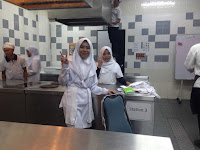HACCP ( A FOOD PROTECTION SYSTEM) - CHAPTER 3 - CLASS ACTIVITY - GROUP
HACCP is Hazard Analysis and Critical Control Point, a
systematized approach to preventing food borne illness during the production
and preparation of food.
What is Critical Control Point (CCP) ?
A point in the HACCP process that must be controlled to
ensure the safety of the food
SEVEN HACCP PRINCIPLES
1. Identify Hazard
*Review you menu of product list
to identify all the potentially hazardous foods you serve.
* Potentially hazardous foods include;
meats, dairy products, poultry, eggs and cooked fruit such as pasta, rice.
- Biological hazards
- Chemical hazards
- Physical hazards
2. Determine
(Identify) Critical Control Points (CCPs)
* A critical control point is an operation in the flow food
which will prevent, eliminate, of reduce hazards to acceptable levels.
- Cooking, reheating and hot-holding
- Chilling, chilled storage and chilled display
3. Determine Safety
Limits For CCPs
* Considering what should be done to reduce the hazard risk
to safe levels
* Should be
specific as possible
* Control time
& temperature
- Ground beef must be hated to an internal temperature of
155 F (68 C) or greater for at least 15 seconds
4. Monitor CCPs
* In each food establishment, someone should be responsible
for monitoring critical control points.
* The risk of food borne illness increases when a CCP is not
met
- Monitoring tells you whether or not the internal
temperature of poultry has reached 165 F (74 C) or above for 15 seconds.
5. Establish the
Corrective Action To Be Taken When Monitoring Shows That a Critical Limit Has
Been Exceeded
* Serious problems can occur when critical limits are not
met yet
* The flow of food should not continue until all CCPs have
been met
- If the temperature of the BBQ chicken on the steam table
is not 135 F (57 C) or higher, check the steam table to make sure it is working
properly and will keep food hot. Put the chicken on stove and reheat it rapidly
to 165 F (74 C), on temperature danger zone for 4 hours or more.
6. Establish
Procedures To Verity That The HACCP System Is Working
* The verification process
typically consists 2 phases
- Verify the critical limits that have been established for
CCPs will prevent, eliminate or reduce hazards to acceptable levels.
- Verity the overall HACCP plan is functioning effectively.
7. Establish An
Effective Record Keeping System That Documents The HACCP System
* Written HACCP plan that provide as much information as
possible about hazards associated with each individual food item or group of
food covered by the system.
* Clearly identify each CCP and the critical limits that
have been set for each CCP.
* The procedures for monitoring CCP and record maintenance
must also be contained in the establishment’s HACCP
plan.





Comments
Post a Comment